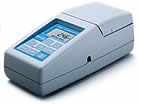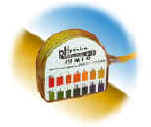(Please read carefully before sampling)
Participating in the Dip-In is easy:
Submit your data to the Secchi Dip-In Database. There are a few ways you can do this:
Secchi Dip-In Online Database: enter your data for the Secchi Dip-In using the data entry system provided by Gold Systems/AWQMS.
This is a newer data entry system for the Dip-In, so Dip-In accounts created prior to 2020 will not work. Please refer to our How-To Videos page for instructions on how to set up your account.
Submit Your Data
Lake Observer App: You can participate in the Secchi Dip-In and support lake-monitoring efforts by submitting your data through the Global Lake Ecological Observatory Network’s (GLEON) Lake Observer App. You can use a mobile app, the new web-based data entry form or a batch data entry form (registration and login is required). Training videos for downloading and using the mobile app to submit data to the Secchi Dip-In can be found here: https://www.lakeobserver.org/guide.
Secchi Dip-In Paper Form: If you prefer the old-fashioned way of entering your data on a paper form, you can download a copy of the paper form here and send it to us via email or regular mail (instructions provided on the form).
Even for those using the spreadsheet or the app, we recommend also recording your observations on a paper form or in a field notebook.
Please submit via the app or one of the other methods listed above … but not more than one!
View the “How to Take a Secchi Depth” video (produced by students!) available on NALMS’ YouTube site.
Enjoy lake time, snap some #LimnologySelfies, submit #SecchiDepth measurements, and share with us on social media (tweet @SecchiDipIn; Secchi Dip-In Facebook page)!
Secchi disks are easy to purchase or make and use! Everyone willing to learn how to properly use a secchi disk (or who already knows how) is welcome to submit data to The Secchi Dip-In.
- Local, state, and national volunteer monitoring programs.
- Individuals or groups who measure transparency as part of their profession, but who are not part of a volunteer program, may also participate.
- The instructor of a class or project (please register and enter the most reliable set of data).
- We accept data from North America.
A quick-start video (produced by students!) is available on NALMS’ YouTube site.
Connecting with a local or state volunteer monitoring program is a fantastic way to learn to use equipment properly and to make sampling a social event.
The Dip-In encourages the participation of volunteer monitoring programs who monitor transparency, temperature, or pH in rivers, streams, estuaries, lakes or reservoirs.
Qualified persons who measure transparency as part of their profession but are not part of a volunteer program may also participate. If you are participating as the instructor of a class or project, please have the instructor register and enter the most reliable set of data.
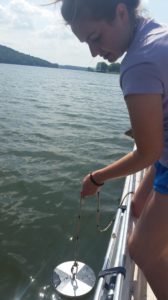
Olivia Reda (Indiana University Clean Lakes Program Employee) taking a Secchi disk measurement at Lake Lemon. Photographed by Melissa Laney.
When Should I Sample?
- We prefer measurements taken on any day during July, but accept data year-round.
- Collect the data between the hours of 10:00 a.m. and 4:00 p.m. (remember to specify AM/PM on the sampling form!).
- **Note: If you routinely monitor a site, sample when you normally would.
- Transparency measurements should be taken on the shady side of the sample area.
- AVOID sampling when:
- it is raining
- there is abnormally high boat traffic
- your safety would be at risk
Where Should I Sample?
- Any lake you normally visit is a candidate for sampling. If you perform routine lake monitoring, sample at your routine location.
- If you sample at more than one lake or site, please provide accurate names and coordinates (coordinates for the actually sampling location are best) for each site so that we can map the lake.
- If you submit data for multiple sites, enter the data for each site separately.
What and How to Sample
Follow your routine monitoring procedures and report the data gathered. Do not use a technique or method that is not approved by your coordinating program!
Please enter your data using one of the methods described above. If it is impossible for you to access a computer, or if you would like to take a copy of the questionnaire with you when you sample, a shortened version of the form is available for download.
Another data entry option is to use the Lake Observer mobile app, web app, or batch upload. Training videos for downloading and using the mobile app to submit data to the Secchi Dip-In can be found here: https://www.lakeobserver.org/guide. Please remember to submit via the app or one of the other methods listed on this website, but not both!
Volunteer Name, Address and Phone Number: If we have questions about your submission, we will contact you using the information you provide. The best way to avoid an email or a phone call from us is to carefully fill in all blanks. Enter only the name of the trained volunteer who takes the readings.
Site Name and Location: Please enter the official name of the site. This should be the same as the one you report to the monitoring program, but you can check with the place name databases below to be sure. Help us locate the site by providing information on the county the site located and the ZIP or Postal Code of the site or nearest town. Some lakes and streams straddle several counties, so please put the name of the county where your sampling site is located. We also appreciate longitude and latitude coordinates of your site. If you do not have a GPS system or haven’t been given the information by your program coordinator, you can obtain information on official site names and locations at:
Map Coordinates
Town and Waterbody Names
- United States: Geographic Names Information System (GNIS)
- Canada: Canadian Geographical Names Data Base (CGNDB)
If your program has given your site an official identifying label, be sure to include it. This helps when we supply the data back to your program.
We accept several types of data: Transparency and Turbidity, Temperature and pH.
Be sure to fill in the type of instrument you are using and, especially important, the units (feet, inches, meters, centimeters, etc.) in which the reading is measured.
Secchi Disk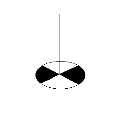 A Secchi Disk is usually an 8-inch (20 cm) disk with alternating black and white quadrants, though some programs use an all-white disk. The disk is lowered into the water until it can no longer be seen by the observer. This depth of disappearance is called the Secchi depth. Some programs view the disk through a viewscope which may have a bottom lens or an open end. A Secchi Disk is usually an 8-inch (20 cm) disk with alternating black and white quadrants, though some programs use an all-white disk. The disk is lowered into the water until it can no longer be seen by the observer. This depth of disappearance is called the Secchi depth. Some programs view the disk through a viewscope which may have a bottom lens or an open end. |
Turbidity Tube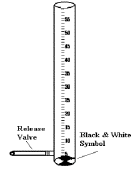 A turbidity tube (sometimes called a sediment stick or similar name) is a clear tube with some sort of marking on the inside bottom. The tube is filled with water until the marker cannot be seen. Turbidity tubes are often used in streams where the depth is too shallow for a Secchi disk to be used successfully. A turbidity tube (sometimes called a sediment stick or similar name) is a clear tube with some sort of marking on the inside bottom. The tube is filled with water until the marker cannot be seen. Turbidity tubes are often used in streams where the depth is too shallow for a Secchi disk to be used successfully. |
LaMotte Turbidity Column The LaMotte Company has a turbidity test kit (7519) that uses a “Turbidity Column” that measures turbidity against a formazin standard. This measures turbidity in Jackson Turbidity Units (JTU). The LaMotte Company has a turbidity test kit (7519) that uses a “Turbidity Column” that measures turbidity against a formazin standard. This measures turbidity in Jackson Turbidity Units (JTU). |
| Turbidity Meter or Turbidimeter
A turbidity meter is an electric device that measures turbidity. Depending on the model, turbidity is normally measured in Nephelometric Turbidity Units (NTU) or Formazin Turbidity Units (FTU). |
Vertical Black Disk A vertical black disk consists of a black disk held vertically and observed through an inverted periscope. It is used in shallow water situations and may even be a better measure of clarity than a Secchi disk. A vertical black disk consists of a black disk held vertically and observed through an inverted periscope. It is used in shallow water situations and may even be a better measure of clarity than a Secchi disk. |
| Temperature Temperature is measured by a number of devices, both electronic and mechanical. Readings can be reported in degrees Fahrenheit (F) or in degrees Celsius (C). |
| pH
pH is an estimate of the hydrogen ion concentration in a solution. It is measured by a number of devices, both with electronic and with paper indicator strips. |
If you need help getting access to a Secchi disk (or other transparency equipment), please contact us at secchidipin@nalms.org. We are happy to help you discover your options!
We are very interested in your perception of the quality of the water and the factors that affect that perception.
Water Quality: Mark your opinion of the suitability of the lake for recreation and aesthetic enjoyment. The term “overall water quality” should include your general impression of the quality of the lake over the past few weeks. Do not include factors such as weather.
Management Practices: Please describe what efforts are being taken to protect or improve water quality. We are interested in whether our waterbodies are being protected from pollution. If you have answered this question for us in the past and there is no new news, you don’t have to answer again.


